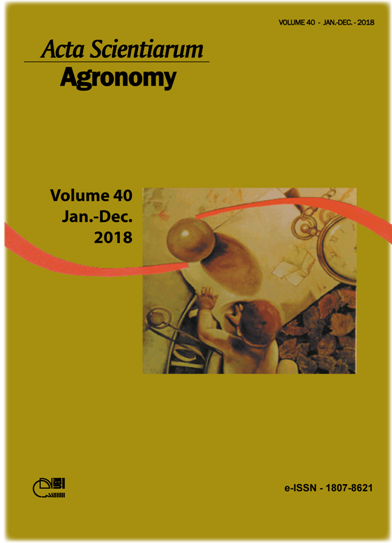<b>Growth and physiology of jelly palm (<i>Butia capitata</i>) grown under colored shade nets
Resumo
Butia capitata (Mart.) Becc., commonly known as jelly palm, is a palm tree native to the Cerrado biome. It is considered an endangered species owing to intensive extractive exploitation of its fruits, with slow and uneven seminiferous propagation as an aggravating factor. Thereby, there are some bottlenecks related to jelly palm seedling production that needs to be optimized. Light quality and intensity is very important to seedling production, as it controls the metabolism of plants and consequently their growth and development. Thus, the aim of this work is to evaluate the effect of shade nets on the growth and physiological aspects of jelly palm seedlings. The experimental design was completely randomized, with five treatments, ten replicates and eight plants per replicate, totaling 400 plants. Experimental treatments consisted of the use of shade nets with 50% shading and different radiation intensity: white (985 µmol m-2 s-1), red (327 µmol m-2 s-1), black (433 µmol m-2 s-1), and silver (405 µmol m-2 s-1). Full sun (1000 µmol m-2 s-1) was used as the control treatment. Growth and physiological analyses of the plants were performed after six months of treatment. We concluded that the red shade net increases growth and biomass of Butia capitata plants. However, the use of shade nets had no effect on the tested physiological characteristics of this species. The red shade net is the most suitable for the production of Butia capitata seedlings in the southern region conditions of Minas Gerais State.
Downloads
DECLARAÇÃO DE ORIGINALIDADE E DIREITOS AUTORAIS
Declaro que o presente artigo é original, não tendo sido submetido à publicação em qualquer outro periódico nacional ou internacional, quer seja em parte ou em sua totalidade.
Os direitos autorais pertencem exclusivamente aos autores. Os direitos de licenciamento utilizados pelo periódico é a licença Creative Commons Attribution 4.0 (CC BY 4.0): são permitidos o compartilhamento (cópia e distribuição do material em qualqer meio ou formato) e adaptação (remix, transformação e criação de material a partir do conteúdo assim licenciado para quaisquer fins, inclusive comerciais.
Recomenda-se a leitura desse link para maiores informações sobre o tema: fornecimento de créditos e referências de forma correta, entre outros detalhes cruciais para uso adequado do material licenciado.




















































